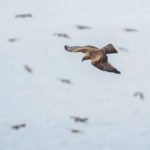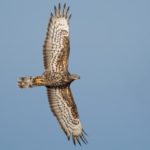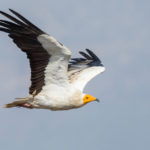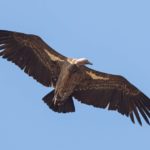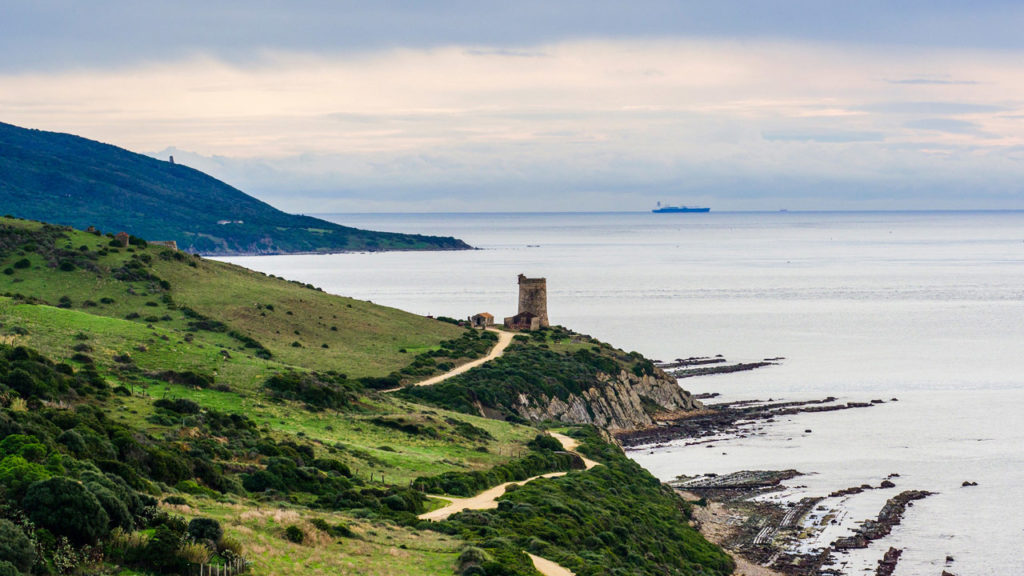
Strait of Gibraltar Birding Tour
The best bird migration in Spain
• Price: 1725€
• Dates: Sept 5-11, 2024
• Places available: 2
Overview

The Strait of Gibraltar is one of the busiest raptor migration corridors on earth. Here you can also find the best bird migration in Spain. The autumn migration is the best to observe large numbers of raptors sea-crossing from Europe to Africa. Some of the most remarkable raptor species include: Black Kite (>80.000), Booted-Eagle (>10.000) Short-toed Eagle (>12.000), etc. This is also an optimal period to observe flocks of Black and White Storks on migration. Other raptors on migration during this period include Egyptian Vulture, European Honey-Buzzard, Sparrowhawk, Montagu’s and Marsh Harrier, Osprey, Lesser Kestrel and Hobby.
In addition to observe the active raptor migration, on this Strait of Gibraltar Birding Tour we will explore the former Lagoon of La Janda. Here we will search for resident raptors such as the Spanish Imperial Eagle, Bonelli’s Eagle and Black-winged Kite. We will look for the reintroduced and critically endangered Northern Bald Ibis and will visit the only colony of Little Swifts in Europe, a recent coloniser from Africa.
On this tour we will also have the chance to visit Doñana Nature Reserve, specifically the one of the least visited areas of Doñana, on the east bank of the Guadalquivir River. This is one of the most rewarding birding sites in the province: White-headed Ducks, Marled Teals, and large numbers of waders and flamingos all occur here. We will also look for the very scarce Red-knobbed Coot.
Tarifa, the flagship city in the Strait of Gibraltar and the southernmost village on the continent, will be our base to explore the Strait of Gibraltar.
Last, but not least, this trip will take us to remarkable sightseeing spots, including the charming city of Ronda, Gibraltar and the Roman Archaeological site of Baelo Claudia.
Itinerary
Day 1: arrival to Malaga, Guadalhorce River Mouth and drive to Tarifa.
We start this Strait of Gibraltar Birding Tour at the Malaga Airport. Right after arrival to Málaga, time permitting, we will visit the nearby Guadalhorce River Mouth Nature Reserve, just ten minutes drive from the airport. Here we will get an excellent introduction to the Mediterranean bird community, including: Greater Flamingo, White-headed Duck, Kentish Plover, Whiskered Tern, European Bee-eater, Iberian Yellow Wagtail, Spotless Starling, Crested Lark, Red-rumped Swallow, Sardinian Warbler, Zitting Cisticola, European Serin and the first Booted Eagles of the trip, to name few.
After a picnic lunch at the observatories we will drive to Tarifa. The sight of the Rock of Gibraltar will indicate that we have reached the Strait of Gibraltar and we will get the first striking views of the African continent. Just before the check in at the Hotel in Tarifa, we will look for raptors foraging around and get used to the special ambience of the Strait of Gibraltar for the days to come. Overnight in Tarifa.
Day 2: Los Lances, Migration Observatories and La Janda.
After breakfast at the Hotel we will visit the nearby Los Lances beach observatory, overviewing a coastal lagoon. Here we will look for Audouin’s and Mediterranean Gulls, Kentish Plovers and Terns. The surrounding pastures are excellent for an array of passerines including Zitting Cisticola, Tawny Pipit, Corn Bunting and the Iberian race of the Yellow Wagtail. Then, we will head to the best raptor migration observatories in the Tarifa area, just at the moment when thermal updrafts take power activating the movement of raptors. We will keep constant communication with local raptor counters to make sure that we are visiting the best spots at the best moment of the day: remarkable numbers of Short-toed and Booted Eagle, Black Kite, Marsh and Montagu’s Harrier, Egyptian Vulture and Eurasian Sparrowhawk, are to be expected.
In the afternoon we will explore La Janda.This large area is home to large communities of passerines, waterbirds and raptors. Montagu’s, Marsh Harrier, Black-winged Kite, Black Kite, Booted Eagle and Short-toed Eagle forage here. This is also one of the best places in Spain to observe Bonelli’s Eagle and the endemic Spanish Imperial Eagle. Overnight in Tarifa.
Day 3: seawatching from Tarifa, Migration Observatories and Sierra de la Plata
Tarifa Island is the southernmost point in Europe. This island is home to a spectacular Yellow-legged colony, and from here we will have a seawatching session looking for Scopoli’s and Balearic Shearwater, Great and Parasitic Skua, as well as Northern Gannet. Next we will spend some time observing raptor migration at the observatories.
During the second part of the day we will visit the nearby Bolonia and Sierra de La Plata area, within El Estrecho Natural Park, which offers one of the most beautiful scenic views of the Strait of Gibraltar, including the African coast, sand dunes, cliffs and the ancient Roman city of Baelo Claudia. The cliff in this area hold a large Griffon Vulture colony and the endangered Egyptian Vulture and vagrant Rüppell’s Griffons are regularly seen here too. This is also an excellent place to observe the Blue Rock Thrush, Cirl Bunting and Thekla Lark. Overnight in Tarifa.
Day 4: full day in Doñana Nature Reserve
Today we will depart early from the Hotel, as we will visit the Outskirts of Doñana National Park in Cádiz (1:45 hours drive from Tarifa), East of Guadalquivir River. This is one of the least visited and most rewarding birding areas in Doñana. A mosaic of fish farming and salt work facilities, along with lagoons, vineyards and pastures, creates a diverse wetland. Large numbers of Flamingos, Waders (ca. 20 species), Egrets and Herons will be present in the area, along with Slender-billed Gulls, Little and Caspian Terns and Western Swamphens. Lesser Short-toed Larks are easily spotted here as well. Some for main main targets will be the White-headed Duck and the Marbled Teal, which often provide good views in the pools. We will also have a chance to see the Little Swift while we visit the only breeding colony in Europe. Overnight in Tarifa.
Day 5: Barbate Marshes, Northern Bald Ibis and Whale Watching
After breakfast at our hotel we will drive along one of the best preserved coastal areas of Spain. The road will take us to the Barbate Marshes. Here, there are chances for good flocks of waders and gulls. Stone-Curlews hide in the islets of the former salt plants, and Greater Flamingo occur here as well. This can also be a good spot for migrating passerines, that take cover in the isolated tamarisks or forage on the ground, like the Tawny Pipit and the Greater Short-toed Lark. We will also look for the critically endangered Northern Bald Ibis. After a successful reintroduction project, this critically endangered species is breeding again in the Strait of Gibraltar, holding over 22 pairs and 90 individuals in 2017. This is a unique chance to observe and photograph one of the rarest species on earth.
In the afternoon we will take our whale watching trip. The rich water of the Strait holds three different types of resident dolphins: Common, Striped and Bottlenose and Long-finned Pilot Whales. Also, migratory species use its water during migration and on our tour dates, including Sperm and Fin Whales. Overnight in Tarifa.
Day 6: Grazalema and Ronda Mountains
Today we will head inland, up to the mountains inland Cádiz and Málaga province, a radically different landscape. The limestone outcrops create a beautiful scenery and is home to the Spanish Ibex. Here, we will have the chance to observe Black Wheatear, Rock Bunting and Rock Sparrow. In term of Raptors, Griffons are widespread and we will have the chance to observe Bonelli´s and Golden Eagle. Along the way, we will pass through several “Pueblos Blancos” (White villages) which are typical in this region of Spain. We will spend the afternoon in Ronda, one of the most charming historical cities of the country.
The city is located on a mountainous area of an enormous outcropped rock approximately 750 meters above sea level where Crag Martin, Alpine Swift and Red-billed Chough are widespread, and Peregrines of the Mediterranean Brokeei subspecies breed too. Ronda and its historic bullring are considered the home of the modern bullfighting. Overnight in Ronda.
Day 7: Fuentedepiedra and drive to Malaga Airport
On our last day of the Strait of Gibraltar Birding Tour we will spend our last morning in the productive lagoon of Campillos or Fuentedepiedra. Here, depending on water levels, we can find good numbers of waterbirds and waders, along with some migrating passerines and other interesting species, like Western Olivaceous Warbler and Iberian Grey Shrike. This will be a great way to end our tour and say “until the next time!”.
* Note: we will keep the itinerary flexible in order to maximise our chances to get the best possible migration experience.
Species
Species of interest on the Strait of Gibraltar Birding Tour
- Marbled Teal
- White-headed Duck
- Red-legged Partridge
- Greater Flamingo
- Northern Bald Ibis
- Little Bustard
- Western Swamphen
- Red-knobbed Coot
- Kentish Plover
- Slender-billed Gull
- Audouin’s Gull
- Mediterranean Gull
- Little Tern
- Whiskered Tern
- Scopoli’s Shearwater
- Balearic Shearwater
- Egyptian Vulture
- Griffon Vulture
- Rüppell’s Vulture
- European Honey-Buzzard
- Short-toed Eagle
- Booted Eagle
- Spanish Imperial Eagle
- Bonelli’s Eagle
- Montagu’s Harrier
- Eurasian Sparrowhawk
- Black Kite
- Black-winged Kite
- European Turtle-Dove
- Red-necked Nightjar
- Alpine Swift
- Pallid Swift
- Little Swift
- White-rumped Swift
- European Bee-eater
- Iberian Green Woodpecker
- Lesser Kestrel
- Iberian Grey Shrike
- Woodchat Shrike
- Calandra Lark
- Lesser Short-toed Lark
- Thekla lark
- Red-rumped Swallow
- Sardinian Warbler
- Western Olivaceous Warbler
- Black Wheatear
- Black-eared Wheatear
- Blue Rock-Thrush
- Spotless Starling
- Western Yellow Wagtail
- Tawny Pipit
- European Serin
- Cirl Bunting
- Rock Bunting
- Corn Bunting
- Spanish Sparrow
- Rock Sparrow
What’s included
The price of this Strait of Gibraltar Birding Tour includes:
- All accommodation from day 1 until day 7 (6 nights).
- All meals, starting with lunch on Day 1 until breakfast on Day 7. This includes 1 drink with every meal and water during the whole duration of the trip.
- Transportation in a comfortable vehicle for 5 or 9 pax depending on the final number of participants.
- Programmed entrance fees as in the itinerary.
- A specialised birding guide fluent in English with extensive experience in Tarifa and the Strait of Gibraltar.
- Welcome package with itinerary, travel information and checklist of the birds of the region.
Items not included in the price:
- Any flights.
- Extra drinks.
- Tips in hotels, service and guides.
- Personal travel insurance.
- Personal items.
For further details on bookings and cancellations, you can check out our general Terms and Conditions.
If at any time you have questions about this trip, payments, or other related topics please feel free to contact us.
Tour Basics
- Guides: Javi Elorriaga and Yeray Seminario, local guides from Birding The Strait who are based in Tarifa.
- Length: 7 days.
- Single Supplement: 350€
- Lodging: Mesón de Sancho Hotel in Tarifa and Hotel Maestranza in Ronda.
- Food: excellent, traditional Spanish with some international food. Mesón de Sancho manages one of the most renowned restaurants in the region.
- Weather: warm temperatures throughout most of the trip. A jacket and a sweater are recommended for evenings. A rain jacket can be useful for the whale watching boat trip.
- Difficulty: easy, short walks and gentle pace. For the most part, short drives for the most part, with just a couple of days with drives over 1.5h.
Tour Gallery

